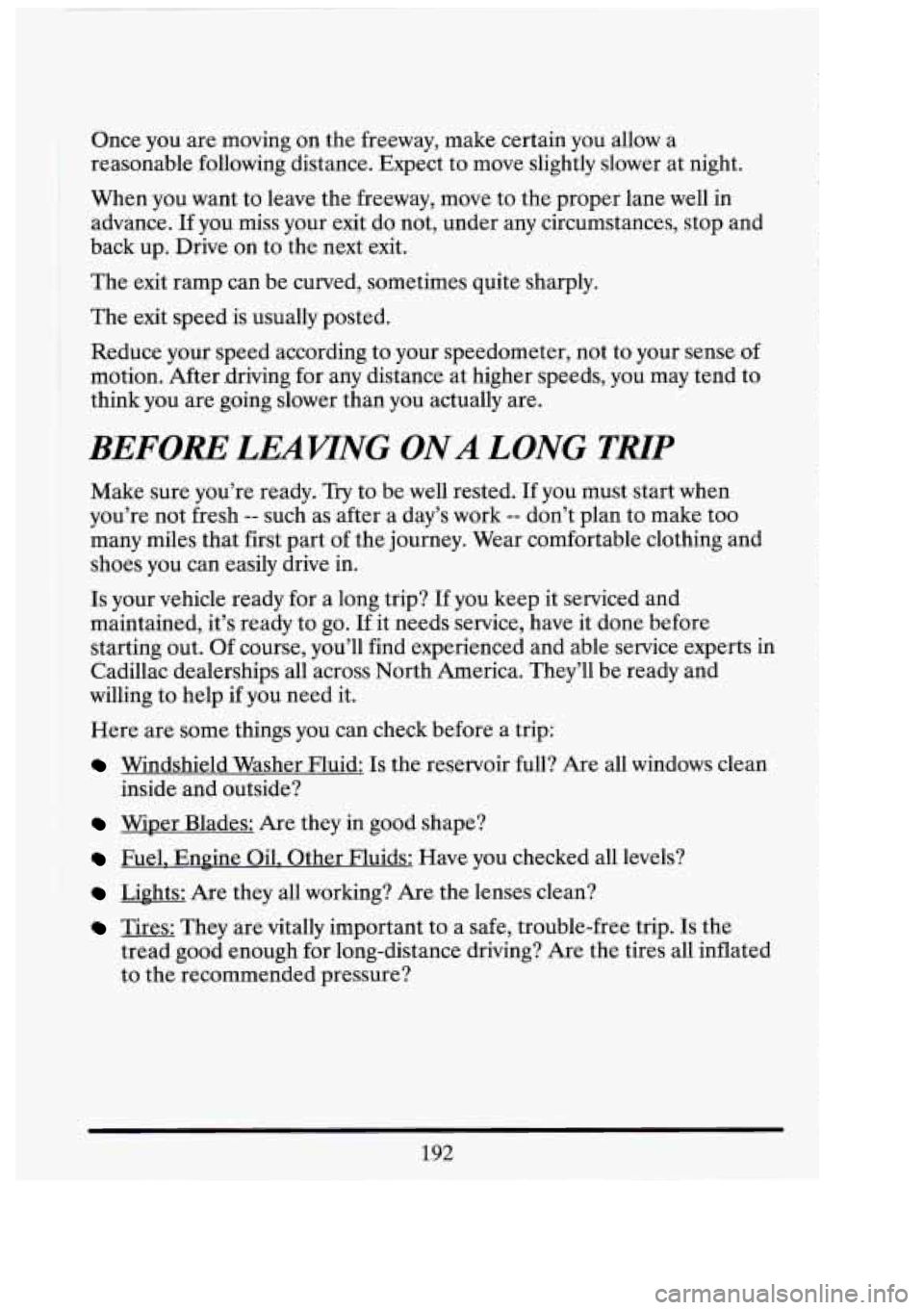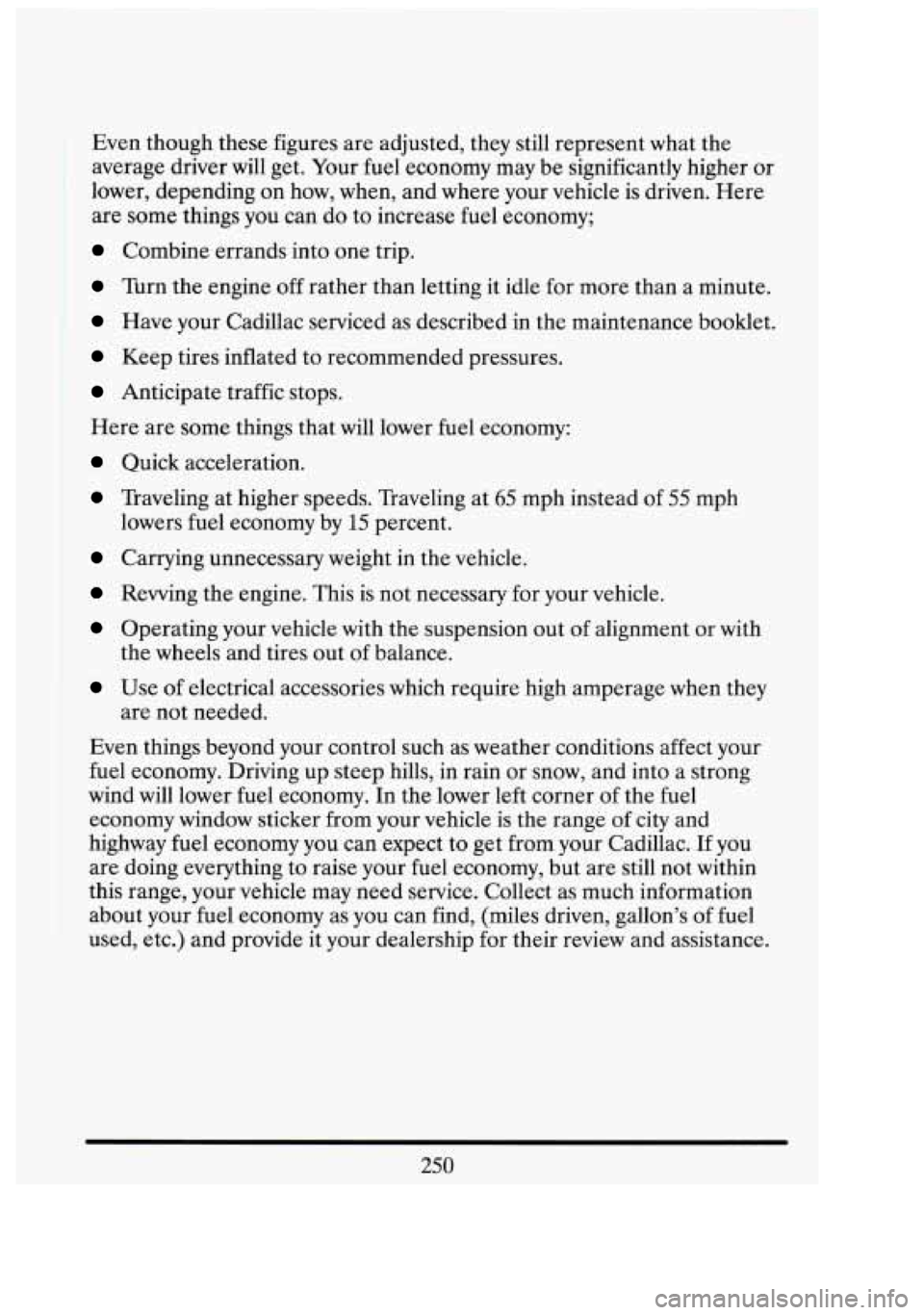Page 18 of 398
These symbols are used on warning and indicator lights:
-I
I BRAKE I
I
ENGINE COOLANT
TEMPERATURE RADIATOR
COOLANT
CHARGING
1 FUEL 1 I
ENGINE OIL
PRESSURE 1 I
ENGINE OIL
TEMPERATURE I I I ANTILOCK BRAKE
.Here are some other symbols you may see:
-%r
FUSE I RADIO SELECTOR I
RADIO VOLUME AIR
CONDITIONING I
TRUNK HATCHBACK RELEASE SPEAKER
I
Page 205 of 398

I
Once you are moving on the freeway, make certain you allow a
reasonable following distance. Expect to move slightly slower at night.
When you want to leave the freeway, move to the proper lane well in
advance.
If you miss your exit do not, under any circumstances, stop and
back up. Drive on to the next exit.
The exit ramp can be curved, sometimes quite sharply.
The exit speed is usually posted.
Reduce your speed according to your speedometer, not to your sense of
motion. After driving for any distance at higher speeds, you may tend to
think you are going slower than you actually are.
BEFORE LEAWNG ONA LONG TMP
Make sure you’re ready. Try to be well rested. If you must start when
you’re not fresh
-- such as after a day’s work -- don’t plan to make too
many,miles that first part of the journey. Wear comfortable clothing and
shoes you can easily drive in.
Is your vehicle ready for a long.trip? If you keep it serviced and
maintained, it’s ready to go.
If it needs service, have it done before
starting out. Of course, you’ll find experienced and able service experts
in
Cadillac dealerships all across North America. They’ll be ready and
willing to help if you need it.
Here are some things you can check before a trip:
Windshield Washer Fluid: Is the reservoir full? Are all windows clean
Wiper Blades: Are they in good shape?
Fuel, EnEine Oil. Other Fluids: Have you checked all levels?
Lights: Are they all working? Are the lenses clean?
inside
and outside?
Tires: They are vitally important to a safe, trouble-free trip. Is the
tread good enough for long-distance driving?
Are the tires all inflated
to the recommended pressure?
Ql
cl‘ I
GI
192
Page 263 of 398

Even though these figures are adjusted, they still represent what the
average driver will get. Your
fuel economy may be significantly higher or
lower, depending on how, when, and where your vehicle is driven. Here
are some things you can do to increase fuel economy;
Combine errands into one trip.
Turn the engine off rather than letting it idle for more than a minute.
Have your Cadillac serviced as described in the maintenance booklet.
Keep tires inflated to recommended pressures.
Anticipate traffic stops.
Here are some things that will lower fuel economy:
Quick acceleration.
Traveling at higher speeds. Traveling at 65 mph instead of 55 mph
Carrying unnecessary weight in the vehicle.
lowers fuel economy
by
15 percent.
Rewing the engine. This is not necessary for your vehicle.
Operating your vehicle with the suspension out of alignment or with
the wheels and tires out
of balance.
Use of electrical accessories which require high amperage when they
are not needed.
Even things beyond your control such as weather conditions affect your
fuel economy. Driving up steep hills, in rain or snow, and into a strong
wind will lower fuel economy. In the lower left corner of the fuel
economy window sticker from your vehicle is the range
of city and
highway fuel economy you can expect to get from your Cadillac. If you
are doing everything to raise your fuel economy, but are still not within
this range, your vehicle may need service. Collect as much information
about your fuel economy as you can find, (miles driven, gallon’s of fuel
used, etc.) and provide it your dealership for their review and assistance.
cl;
31
-1
ra
1-1
ra
250
Page 306 of 398
r
c-
NOTICE:
Don’t let anyone tell you that underinflation or overinflation is
all right. It’s not. If your tires don’t have enough air
(underinflation) you can get:
0 Too much flexing
0 Too much heat
0 Tire overloading
Bad wear
0 Bad handling
0 Bad fuel economy.
If your tires have too much
air (overinflation), you can get:
Unusual wear
0 Bad handling
0 Rough ride
Needless damage from road hazards.
When to Check Check your tires once a month or more.
Don’t forget your compact spare tire. It should be at
60 psi (420 kPa).
How to Check Use a good quality pocket-type gage to check tire
pressure. Simply looking at the tires will not tell
you the pressure,
especially if you have radial tires
-- which may look properly inflated even
if they’re underinflated.
If your tires have valve caps, be sure to put them back on. They help
prevent leaks by keeping out dirt and moisture.
Your tire pressures are:
0 Front and Rear - 30 psi (210 kPa)
293
Page 328 of 398

FUSE USAGE CHART
0
FOR MORE INFORMATION, SEE OWNER’S MANUAL
UNDERHOOD (U/H) ELECTRICAL CENTER BODY 1 (SO AMP)
I/P FUSE BLOCK
#3 PWR. SEAT CIRCUIT
BREAKER (30 AMP)
#36 TRUNK PULL-DOWN
#37 HAZARD LTS. (20 AMP)
(15 AMP)
#39 PWR. LUMBAR (20 AMP)
#40 HEATED SEAT (20 AMP)
#44 STOP LTS. (20 AMP)
#45 PWR. LOCK (20 AMP)
BODY 2 (50 AMP)
I/P FUSE BLOCK
- #21 RAP BAT (25 AMP)
- #22 HVAC MDL. (25 AMP) - #26 ELC. SENS. (20 AMP) - #27 D/INT LTS. (1 5 AMP) - #28 FRT CIG. (1 0 AMP) - #29 RR. CIG. (20 AMP) - #30 EBTCM (25 AMP) - #33 HVAC BAT (10 AMP) - #34 CCM BAT (10 AMP) - #35 PWR. MIR. (10 AMP) - #2 CIRCUIT BREAKER - RAP RLY (30 AMP) 3 - ION 1 (50 AMP) - I/P CONCEALED FUSE - RKE/UTD SA - I/P FUSE BLOCK - #6 T/SIS-ICA - #7 EBTCMDPS (1 0 AMP) - #8 RAP WPR. (25 AMP)
- #10 WIPER (25 AMP) - #9 RADIO (10 AMP)
- #li I/P IiDC (10 AMP) - #12 ELC. IGN. 1 (10 AMP) - #13 CHIME (10 AMP) - #14 CCM IGN 1 (10 AMP) - #15 AIR BAG (1 5 AMP) - #24 STARTER, U/H ELC. CNTR. - #15 PCM/IGN (10AMP) - #16 INJ 1 (10AMP) - #17 EMISSIONS (1 0 AMP) - #18 INJ 2 (10 AMP) 4 - ION 3 (40 AMP)
I/P FUSE BLOCK
- #16 GEN. (10 AMP) - #17 MEM. SEAT (10 AMP) - #18 CCM IGN 3 (10 AMP) - #19 RAP PWR. (30 AMP) - #20 A/C COMF! (10 AMP) - #25 HVAC IGN (10 AMP)
- BRAKE PRESSURE 5 - ABSRC (60 AMP)
MODULATOR VALVE (BPMV) 6 - NOT USED 7 - SCNDRY CLG FAN (40 AMP) - SECONDARY COOLING FAN
CNTRL. RELAY
8 - PRIMRY CLG FAN (40 AMP) - PRIMARY COOLING FAN
9 - LEVEL CNTRL. (30 AMP) CNTRL. REIAY
- AUTOMATIC LEVEL CNTRL.
10 - ENGINE (30 AMP) AIR COMR
- #13 PCM/FUEL PUMP (15 AMP) - #14 AIR PUMP (20 AMP)
11 - I/P FUSE BLOCK CIRCUIT
BREAKER
- #5 HDLTS (20 AMP) - #31 PARK LTS. (20 AMP) - #32 HORN (25 AMP) 12 - EMPTY 13 - PCM FUEL PUMP 115 AMP) - FUEL PUMP RELA? - FUEL PUMP AND ENGINE OIL PRESSURE INDICATOR SWITCH
MDL (PCM) - POWER TRAIN CONTRL.
14 - AIR PUMP (20 AMP) - SECONDARY AIR IN (AIR)
PUMP RELAY
15 - PCM IGN (10 AMP) - IGN COIL - ELECTRONIC TRANS. - (PCM) POWER TRAIN
CNTRL. MDL.
16- INJ 1 110AMP) ~ - FUEL I‘NJ 1,4,6,7 17 - EMISSIONS (10 AMP) - (A.I.R.) PUMP‘RELAY . - MASS AIR FLOW (MAF)
- HEATED OXYGEN SENSOR’S - EVAPORATIVE EMISSIONS
SENSOR
CANNISTER PURGE
SOLONOID VALVE
18- INJ 2 (10 AMP) - FUEL INJ 2,3,5,8
315